Chem 103 exam 5 - Study guides, Class notes & Summaries
Looking for the best study guides, study notes and summaries about Chem 103 exam 5? On this page you'll find 100 study documents about Chem 103 exam 5.
Page 2 out of 100 results
Sort by
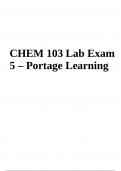
-
CHEM 103 Lab Exam 5 Questions With Answers | Latest Update 2023/2024 (Portage Learning)
- Exam (elaborations) • 3 pages • 2023
-
Available in package deal
-
- $10.49
- + learn more
In the Boyle’s law experiment, how was the volume of gas at different pressures determined? 2. (2 points) According to Boyle’s law, as the volume of a gas decreases, the pressure _________. 3. (6 points) A sample of gas occupies a volume of 10.5 L when the pressure is 14.3 psi. Use Boyle’s Law to calculate the volume (L) when the pressure is decreased to 12.8psi. Show the calculation. Answer: 1. A syringe was used, and the volume was read from the graduation markings. 2. increase...
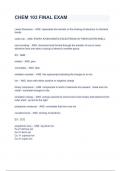
-
CHEM 103 FINAL EXAM QUESTIONS AND ANSWERS ALL VERIFIED
- Exam (elaborations) • 24 pages • 2023
-
- $9.49
- + learn more
CHEM 103 FINAL EXAM QUESTIONS AND ANSWERS ALL VERIFIED Lewis Structures - ANS represents the transfer or the sharing of electrons in chemical bonds octet rule - ANS EVERY ATOM WANTS 8 ELECTRONS IN THEIR OUTER SHELL ionic bonding - ANS chemical bond formed through the transfer of one or more electrons from one atom or group of atoms to another group EX : NaBr metals - ANS give nonmetals - ANS take oxidation number - ANS the superscript indicating the charge on an i...
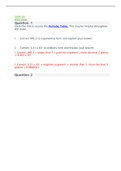
-
CHEM 103 FINAL EXAM
- Exam (elaborations) • 6 pages • 2023
-
- $8.00
- + learn more
CHEM 103 FINAL EXAM Question 1 Click this link to access the Periodic Table. This may be helpful throughout the exam. 1. Convert 845.3 to exponential form and explain your answer. 2. Convert 3.21 x 10-5 to ordinary form and explain your answer. 1. Convert 845.3 = larger than 1 = positive exponent, move decimal 2 places = 8.453 x 102 2. Convert 3.21 x 10-5 = negative exponent = smaller than 1, move decimal 5 places = 0. Question 2 Click this link to access the Periodic Table. This may be ...
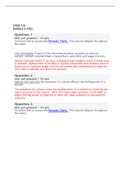
-
CHEM 103 MODULE 6 2022
- Exam (elaborations) • 6 pages • 2023
-
- $8.00
- + learn more
Question 1 Not yet graded / 10 pts Question 2 Not yet graded / 10 pts Question 3 Not yet graded / 10 pts CHEM 103 MODULE 6 2022 Click this link to access the Periodic Table. This may be helpful throughout the exam. List and explain if each of the following solutions conducts an electric current: sodium chloride (NaCl), hydrochloric acid (HCl) and sugar (C6H12O6). Sodium chloride (NaCl) is an ionic compound and conducts since it forms ions in solution. Hydrochloric acid (HCl) is a pola...
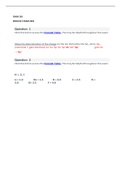
-
CHEM 103 MODULE 5 EXAM 2022
- Exam (elaborations) • 5 pages • 2023
-
- $8.00
- + learn more
CHEM 103 MODULE 5 EXAM 2022 Question 1 Click this link to access the Periodic Table. This may be helpful throughout the exam. Show the determination of the charge on the ion formed by the Se34 atom. Se34 (nonmetal = gain electrons) 1s2 2s2 2p6 3s2 3p6 4s2 3d10 4p4 gain 2e → Se-2 Question 2 Click this link to access the Periodic Table. This may be helpful throughout the exam. H = 2.1 Li = 1.0 Be = 1.5 B = 2.0 C = 2.5 N = 3.0 O= 3.5 F = 4.0 3 3 Na = 1.0 2.1 Mg = 1.2 S = 2.5 Al = 1....
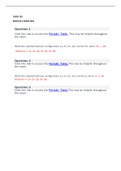
-
CHEM 103 MODULE 4 EXAM 2022
- Exam (elaborations) • 5 pages • 2023
-
- $8.00
- + learn more
CHEM 103 MODULE 4 EXAM 2022 Click this link to access the Periodic Table. This may be helpful throughout the exam. Write the subshell electron configuration (i.e.1s2 2s2, etc.) for the Fe26 atom. Fe26 = 26 electrons = 1s2 2s2 2p6 3s2 3p6 4s2 3d6 Click this link to access the Periodic Table.This may be helpful throughout the exam. Write the subshell electron configuration (i.e.1s2 2s2, etc.) for the S16 atom. S16 = 16 electrons = 1s2 2s2 2p6 3s2 3p4 Click this link to access the Periodic T...
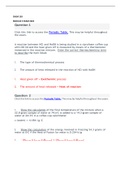
-
CHEM 103 MODULE 3 EXAM 2022
- Exam (elaborations) • 6 pages • 2023
-
- $8.00
- + learn more
CHEM 103 MODULE 3 EXAM 2022 Click this link to access the Periodic Table. This may be helpful throughout the exam. A reaction between HCl and NaOH is being studied in a styrofoam coffee cup with NO lid and the heat given off is measured by means of a thermometer immersed in the reaction mixture. Enter the correct thermochemistry term to describe the item listed. 1. The type of thermochemical process 2. The amount of heat released in the reaction of HCl with NaOH 1. Heat given off = Exother...
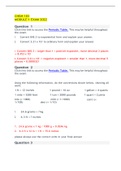
-
CHEM 103 MODULE 1 EXAM 2022
- Exam (elaborations) • 5 pages • 2023
-
- $8.00
- + learn more
CHEM 103 MODULE 1 EXAM 2022 Question 1 Click this link to access the Periodic Table. This may be helpful throughout the exam. 1. Convert 845.3 to exponential form and explain your answer. 2. Convert 3.21 x 10-5 to ordinary form and explain your answer. 1. Convert 845.3 = larger than 1 = positive exponent, move decimal 2 places = 8.453 x 102 2. Convert 3.21 x 10-5 = negative exponent = smaller than 1, move decimal 5 places = 0. Question 2 Click this link to access the Periodic Table. This ...
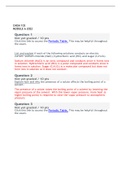
-
CHEM 103 MODULE 6 2022
- Exam (elaborations) • 6 pages • 2023
-
- $8.00
- + learn more
Question 1 Not yet graded / 10 pts Question 2 Not yet graded / 10 pts Question 3 Not yet graded / 10 pts CHEM 103 MODULE 6 2022 Click this link to access the Periodic Table. This may be helpful throughout the exam. List and explain if each of the following solutions conducts an electric current: sodium chloride (NaCl), hydrochloric acid (HCl) and sugar (C6H12O6). Sodium chloride (NaCl) is an ionic compound and conducts since it forms ions in solution. Hydrochloric acid (HCl) is a pola...
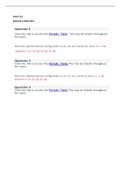
-
CHEM 103 MODULE 4 EXAM 2022
- Exam (elaborations) • 5 pages • 2023
-
- $8.00
- + learn more
CHEM 103 MODULE 4 EXAM 2022 Click this link to access the Periodic Table. This may be helpful throughout the exam. Write the subshell electron configuration (i.e.1s2 2s2, etc.) for the Fe26 atom. Fe26 = 26 electrons = 1s2 2s2 2p6 3s2 3p6 4s2 3d6 Click this link to access the Periodic Table.This may be helpful throughout the exam. Write the subshell electron configuration (i.e.1s2 2s2, etc.) for the S16 atom. S16 = 16 electrons = 1s2 2s2 2p6 3s2 3p4 Click this link to access the Periodic T...

Study stress? For sellers on Stuvia, these are actually golden times. KA-CHING! Earn from your study resources too and start uploading now. Discover all about earning on Stuvia


